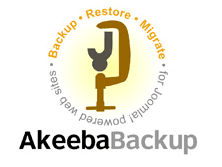Create a Quick Install Package for Joomla
-
-
Written by Nick Savov Nick Savov
-
Published: 12 April 2014 12 April 2014
 Most template clubs have their own Quick Start packages, which help their users to quickly install a demo site with the template, module positions, and sample content already configured.
Most template clubs have their own Quick Start packages, which help their users to quickly install a demo site with the template, module positions, and sample content already configured.
The following article will highlight a quick and easy way to create a Quick Install package for Joomla. And it's with an easy-to-use tool that you've probably already used or heard about: Akeeba Backup.
Workflow
The basic workflow is as follows:
- Create your demo site exactly as you'd like the user to receive it
- Create a backup of your site
- Distribute the backup to your audience
We'll go into each of the above steps in a bit more detail below.
1) Demo Site
The actual content of the site is totally up to you. Whatever you'd like to distribute, make sure it's in the site.
One key to remember is that practically everything that's in your site will be in your backup that you distribute. So if you're distributing the site to the public or to users that can't be fully trusted, you'll need to make sure you take necessary precaution to not leave any details that you don't want others to have. For example,
- Make sure your passwords are generic and unique from any live sites (even demos) that you have
- Your global configuration settings (e.g. FTP info, server paths, database settings, mail settings)
- API information in extensions
- Any other sensitive or unique information
2) Create a Backup of Your Site
This article assumes that you already know how to create a backup using Akeeba Backup. If you don't know how, give either of the following two articles a try:
As you may have noticed, Akeeba Backup creates backups as .jpa files by default. This make it faster to archive and uses less server resources when backing up. However, .jpa's also require the use of kickstart.php (or Akeeba eXtract Wizard) to unpackage the backups. This adds an additional step to the process, which can be eliminated using the below approach.
To make it easier for your users and not require the kickstart.php file, you can change the archive setting to .zip format instead. This is done within Akeeba Backup's configuration settings. Then your users can simply use the unzip tool that comes with most hosting environments or they can unzip locally then FTP the files to the server.
Once ready, backup your site using Akeeba Backup. The resulting .zip file will be the Quick Install package that you distribute.
3) Distribute Your Quick Start Package
The rest of the story is yours for the writing. You'll need to create a way for your users to download the Quick Start package, document it, etc.
From the User Perspective
The advantage to this approach is that it's very easy for the end user to get up and running, especially if they've ever installed Joomla or restored an Akeeba Backup before. It's practically the same thing; except after installing, it will have your demo site instead.
Happy demo-ing!
 Most template clubs have their own Quick Start packages, which help their users to quickly install a demo site with the template, module positions, and sample content already configured.
Most template clubs have their own Quick Start packages, which help their users to quickly install a demo site with the template, module positions, and sample content already configured.